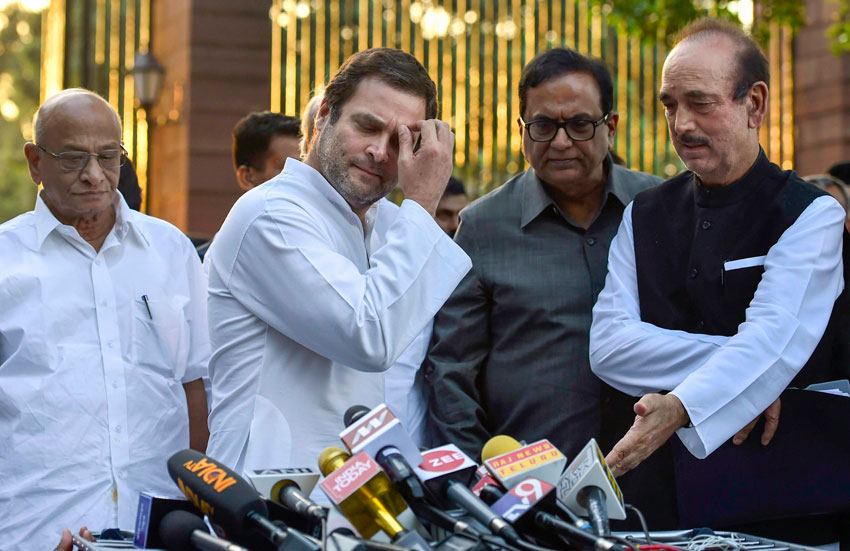Beating Modi in 2019? A Far-Fetched Opposition Dream
Prime Minister Narendra Modi and Amit Shah (r), during the BJP Parliamentary meeting at party headquarters in New Delhi, March 23. (Manvender Vashist/PTI)
Even in the penultimate year of general elections it is clear that the opposition has no chance against Narendra Modi, the Prime Minister of India and head of the ruling National Democratic Alliance (NDA) at the center, writes Priyanka Bhardwaj.
The idea of invincibility of Modi, or any leader in history for that matter, may not be The Truth but his capability to ward off dire circumstances that come in the way of reaffirmation of his claim to the Prime Ministerial berth appears more in place.
However tempting, reasons for this may not be sought in the upsurge of the Saffron in the North East, though unimaginable by every standard, where the Left and Congress were routed from their strongholds, as the successes of the Bharatiya Janta Party (BJP) were well balanced by its near margin victory in Modi’s very home turf of Gujarat and symbolic losses in significant constituencies of Uttar Pradesh, Madhya Pradesh, Rajasthan and Bihar.
While unravelling the ever-dynamic political equations one cannot afford to miss the ever expanding nature of the BJP and evergreen charisma of Modi despite four long years of rule and possible anti-incumbency, accelerated largely by hugely debatable policies of demonetization and cutting down of subsidies.
Therefore, in the absence of a national leader equal in stature to Modi, who would be able to stitch the opposition parties, “woefully divided”, into an anti-Modi alliance?
An erstwhile national party that has been pushed to the fringes (three ruling states and one Union Territory) by the BJP and even regional parties in their respective states the Indian National Congress (INC) is burdened with its own battle for survival and also relevance.
If in Goa and Meghalaya Gandhi failed to out-manoeuver the BJP from stealing the show from right under his nose, in Gujarat he exposed his nervousness in single-handedly taking on Modi and instead resorting to unsuccessful attempts at “temple-hopping politics” to woo Hindus, and recruiting the likes of Jignesh Mewani and Hardik Patel, local leaders who would lack a pan-India appeal, to aim empty bullets at Modi.
Additionally, the record number of consecutive poll debacles has washed away any semblance of a chance for the INC to take on the role of a fulcrum for the non-BJP coalition.

No better proof of this can be sought but from the fact that on her recent visit to the national capital Mamata Banerjee of the Trinamool Congress (TMC) parleyed with a diverse set of opposition leaders, both from the North and South, including the Shiv Sena, Telangana Rashtra Samiti and Aam Aadmi Party, except Gandhi to put together a federal front against the BJP.
It did not go unnoticed when Banerjee skipped Sonia Gandhi’s dinner invite to leaders of all 19 Opposition parties to discuss the need for uniting against Modi in 2019.
With the reluctance to accept Gandhi as the one to lead the anti-Modi front from the front by other senor leaders such as Sharad Pawar of National Conference Party, Chandrababu Naidu of Telugu Desam Party (TDP), and K. Chandrasekhar Rao, the Congress is pushed to relying on the verdicts in the upcoming state polls of Karnataka, Madhya Pradesh and then Rajasthan, and counting on only the DMK and Rashtriya Janata Dal, also facing similar existential crises, as its only allies.
Coming to the CPI (M) which is the Left party with the distinction of weaving anti-BJP alliances, this time hence it is not short on words in clarifying its anti-Congress stand.
The party’s official position as reflected in The People’s Democracy that states, “The best way to defeat the BJP in the next Lok Sabha election will be to pool in all anti-BJP votes state-wise,” is a far cry from the days of Sitaram Yechury who would not mind allying with the Congress to make any anti-BJP dream come true.
It may be remembered that the sudden anathema of the Left for the Congress may also have to do with its direct contest with the latter in Kerala that remains its only bastion of power.
However, with Banerjee as the CPI (M)’s main rival in West Bengal, and the latter’s refusal to join hands with TDP that recently quit the NDA after the Shiv Sena’s declaration of contesting 2019 elections without support of the BJP, who would be the constituents of the pre-poll alliance is uncertain.
No anti-Modi coalition would be worth it if it is unable to capture 120-150 seats out of a total of 543 seats.
Therefore, to arrive at a pre-poll alliance these regional parties will have to resolve their disunity, internal contradictions, egos and ambitions to do a la-V.P. Singh-led coalition of 1989 that ended Rajiv Gandhi’s tenure at the center.
But in an India of 2018, a pre-poll alliance that is unable to throw up a consensus leader will not be able to breach the BJP fortress, let alone puncture the Modi juggernaut, as it is chemistry and voter sentiment that leads the way, and arithmetic that follows to fills up the vacant slots.


